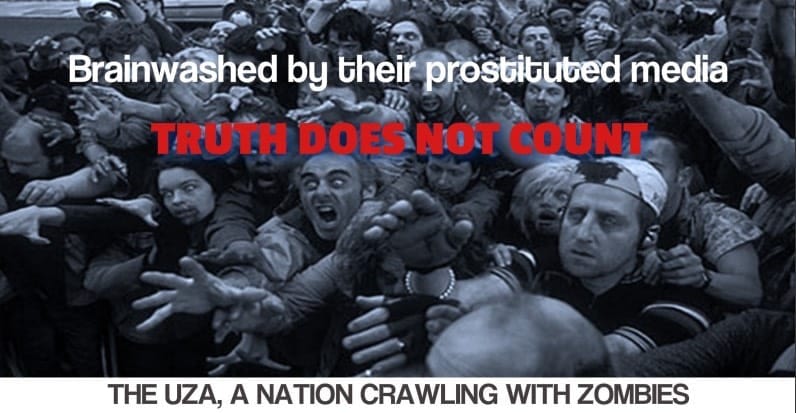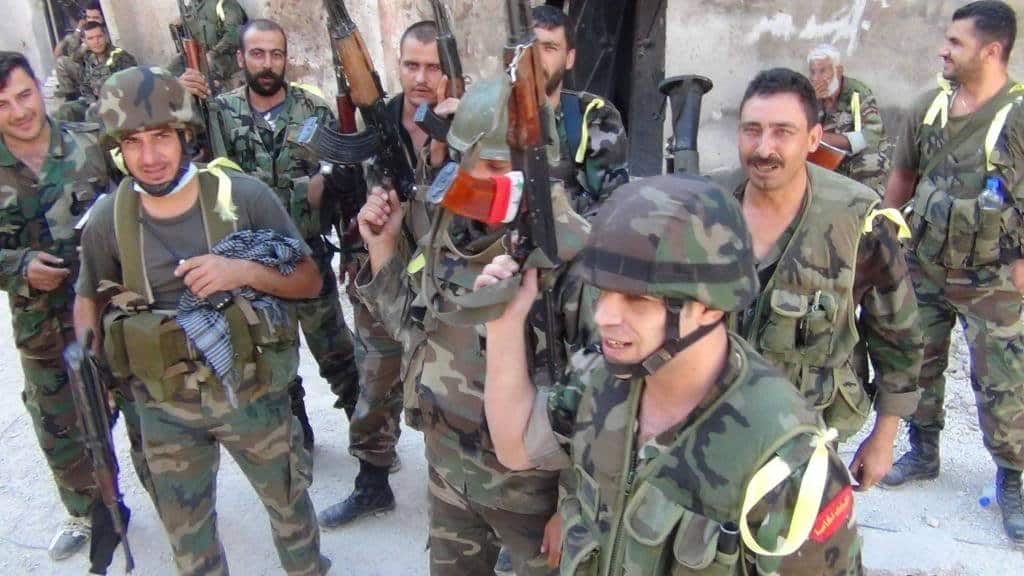HARRISON KOEHLI / SOTT.NET
![]()

The Syrian National Defense Forces – the first line of defense against terror warfare for Syrian towns and villages.
Syria is currently fighting a war that is unprecedented. That’s according to Vasily Pavlov and Andrey Filatov – a Russian journalist and a Russian military man. As they describe in the lecture below, the type of war the Syrian army is fighting is unconventional to say the least. But “terror warfare” probably isn’t as new and unheard-of as they imply – you can already see aspects of it in the Allies’ firebombing of German and Japanese cities in WWII, the use of death squads in Latin America and Southeast Asia, and most recently in the terror wars on Iraq and Libya. But the terror warfare in Syria has arguably gone on longer than intended – Assad and his army have proved more resilient than anticipated, especially after Russia intervened – and the war has morphed into something new simply by virtue of the fact that it takes the black-ops/death-squad approach to another, all-encompassing level.
Vasily Pavlov, Anrey Filatov lecture on terrorist tactics – paralyzing and destroying modern society
They make a few main points. “Traditional” wars are of two types, which often overlap:
- Classical, conventional warfare, with one army targeting another army and its country’s economy via direct military action, for the purpose of defeating the enemy military and capturing territory. Such wars feature masses of soldiers occupying specific locations divided into front lines and rear positions.
- Guerrilla warfare, with small local units of insurgents targeting enemy troops, infrastructure (especially transport), and government via sabotage and ambushes, for the purpose of defeating the enemy military (either their own country’s or an invading/occupying force). Such wars feature increased mobility, camouflage, and support of the local population.
Most historical wars fall into these categories, with overlap, including civil wars and national liberation wars in ex-colonial states. But the war in Syria is different. After a year and a half covering the war, on the ground and with the troops, Pavlov and Filatov share the strange and unique features they saw:
- Terror warfare pits large numbers of lone-wolf attackers and relatively small groups of terrorists against all of the conventional and guerrilla targets, but the terrorists only fight the army when they need to – the main target is the civilian population.
- The main goal is not to take territory, but to create chaos and completely destroy the country, including its government, institutions, and economy.
- Terrorists’ mobility and camouflage is much higher than guerrillas, as they can fully mingle with civilian populations.
- Unlike guerrillas, they do not need the support of the local population. Local civilians are either killed, enslaved, or subjugated.
- They have no classic command and control centers – those are mostly abroad and not essential. Terrorist groups and individuals can and do operate without a strict military hierarchy. (But offensives like the recent on on western Aleppo do require some coordination.)
- Their number of potential targets in the country is equal to the number of its civilians, not to mention any physical structure. Thus, because it is impossible to defend everything, attacks are nearly impossible to prevent.
The reason that the SAA’s advances have been so slow over the years is because the army can’t and doesn’t use much heavy weaponry – at least not to the extent that would be necessary for a swift victory. To do so would be doing the terrorists’ job for them, killing thousands of civilians to kill a hundred terrorists. It is also difficult – psychologically, logistically, and tactically – to mobilize more troops. That requires leaving one’s town, assembling and training at a military location, etc. Each aspect leaves the town and recruit vulnerable to terror attacks. And the attacks can come anywhere and at any time – even if heavy weaponry helps, the terrorists do not need it for their attacks, as they can produce near-industrial amounts of homemade explosives, shaped charges, gas canister bombs, etc., using everyday products. They’re not as effective or powerful as professionally produced munitions, but they are damaging enough, as Pavlov and Filatov show in the lecture. The two also make a few more interesting observations:
- The terrorists purposely use humanitarianism as cover: when they do fight the army, they will also kill the civilians in their own town, then film them and portray them as victims of army attacks.
- At the highest level, it is not a religious war. Religion is just the ideology serving other purposes.
- Terror warfare is most effective on secular states that value human rights and freedoms.
Lastly, they provide some helpful information on the various non-terrorist armed groups involved. The most successful towns and villages in avoiding and repelling terrorist takeover have been those with local citizens’ militias. Many of these groups make up what is called the NDF, or National Defense Forces, who are allied with the Syrian government and army. Other such groups are commonly categorized under the Free Syrian Army (FSA) label, but that’s a misnomer. They are not anti-government per se; they simply protect their town from any external threat and are not under the control of the military. These groups make up the bulk, if not all, of the 600+ who have signed truce agreements with the government via Russia’s reconciliation center.
It’s important to keep all this in mind when watching the latest news and developments in the Syrian war. For example, here are the latest updates from South Front:
Syrian War Report – October 5, 2016: US Considers Military Strikes on Govt Forces
Syrian War Report – October 6, 2016: Up to 60000 Iranian-Backed Fighters Operate in Syria
And check out the R&U Vid YouTube channel, which regularly posts footage of what’s happening on the ground in and around Aleppo. This latest one takes apart Channel 4’s (UK) recent segment “Aleppo: Up close and personal with the rebels (sic)”, where they get up close and personal with some of the people that beheaded a young Palestinian in eastern Aleppo recently:
England’s Channel 4 News featuring “moderate” war criminals | October 5th 2016
In response to the Syrians and Russians refusing to give up their fight on al-Qaeda in Aleppo, the U.S. is considering military options against the Syrian government and military, despite the fact that none of their options have much chance of success. Continuing to arm rebels and striking Syrian bases cut off from the rest of the military will not change anything. A no-fly zone is off the table, and continuing to support groups like the Kurds and SDF is simply more of the same. But still, the U.S. is reportedly considering “covert” strikes on Syrian targets. The U.S. is dead-set against Aleppo being liberated from the grasp of al-Qaeda.
This was reinforced when leaked talks by John Kerry with some Syrian “opposition” showed that despite his participation in negotiations with the Russians, he was actually supportive of military action:
“I’ve argued for use of force. I stood up. I’m the guy who stood up and announced we’re going to attack Assad because of the weapons, and then you know things evolved into a different process,”the Secretary of State said in the tape.
He told the civilians that “you have nobody more frustrated than we are (the US)” that the Syrian issue is now being solved diplomatically [rather than militarily].
As Major General Igor Konashenkov pointed out, such “leaks” usually precede real actions. Which is all the context we really need in order to make sense of the news that Russia has moved S-300 antimissile systems to the Tartus naval base on Syria’s coast. Western media and politicians tickled themselves silly with the opportunity to once again say, “See? Russia isn’t really fighting terrorism! ISIS doesn’t have an air force!” – oblivious to the obvious: that the U.S./NATO is ISIS’s air force, as demonstrated at Deir ez-Zor when they provided air support for an ISIS offensive by bombing Syrian army positions who were at the time fighting ISIS. (See: Escalations in the war on Syria: Russia sends in S-300 missile defense system, Syrian Army advances in Aleppo.) Konashenkov was clear about the purpose of the deployment:
Most officers of the Russian Centre for Reconciliation of the Warring Parties currently work ‘on the ground,’ delivering humanitarian aid and conducting negotiations with heads of settlements and armed groups in most Syrian provinces.
That is why any missile or air strikes on the territory under control of the Syrian government, will create an obvious threat for Russian military.
And finally, I draw attention of ‘hotheads’ that after a strike on Syrian troops in Deir ez-Sor by planes of the coalition on September 17, we have taken all necessary measures to rule out any such ‘mistakes’ against Russian military and military facilities in Syria (NB: this clearly refers to the deployment of the S-300VM Antey-2500 systems to Syria – AM).
The crews on duty will hardly have the time to calculate the missile’s flight path or try to find out their nationality. As for the laymen’s illusions about the existence of ‘invisible planes’ they may confront a disappointing reality.
Yet even after this rather serious warning against any military action against the Syrian army, the U.S. is still considering such action, with U.S. State Department spokesman John Kirby saying: “I have seen the comments out of Moscow — those comments notwithstanding, that conversation inside the US government continues.” And White House spokesman Josh Earnest said that, even though such actions would not be in the U.S.’s national interest, they are still considering them:
“Military action against the Assad regime, to try to address the situation in Aleppo, is unlikely to accomplish the goals that many envision now in terms of reducing the violence there, and is much more likely to lead to a bunch of unintended consequences that are clearly not in our national interest.” However, Earnest added, “I’m not going to take any options off the table.”
In other words, “It’s a really bad idea, but that doesn’t mean we won’t do it.”
These are the kind of people Russia and Syria are up against. Their goals are simple and as described in the lecture at the beginning of this article: the complete destruction of Syria as a nation and civilization.
—Harrison Koehli
Note to Commenters
Due to severe hacking attacks in the recent past that brought our site down for up to 11 days with considerable loss of circulation, we exercise extreme caution in the comments we publish, as the comment box has been one of the main arteries to inject malicious code. Because of that comments may not appear immediately, but rest assured that if you are a legitimate commenter your opinion will be published within 24 hours. If your comment fails to appear, and you wish to reach us directly, send us a mail at: editor@greanvillepost.com
We apologize for this inconvenience.
 What will it take to bring this nation to live according to its own propaganda?
What will it take to bring this nation to live according to its own propaganda?
=SUBSCRIBE TODAY! NOTHING TO LOSE, EVERYTHING TO GAIN.=
free • safe • invaluable
Nauseated by the
vile corporate media?
Had enough of their lies, escapism,
omissions and relentless manipulation?
Send a donation to
The Greanville Post–or
But be sure to support YOUR media.
If you don’t, who will?








